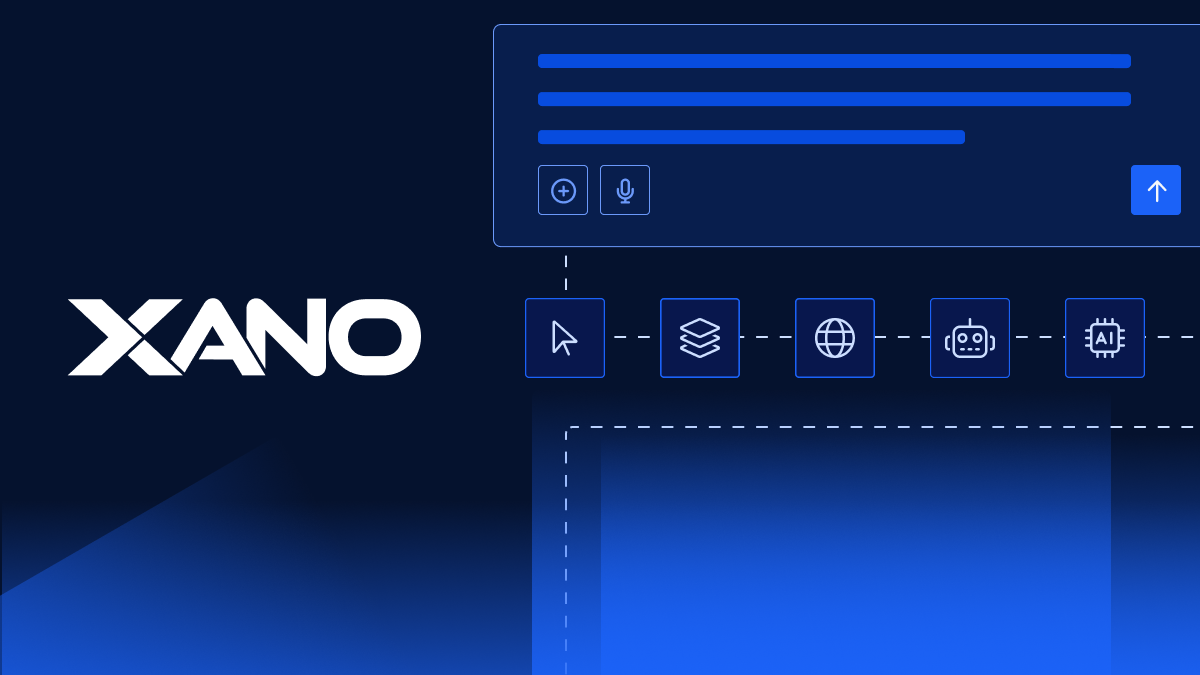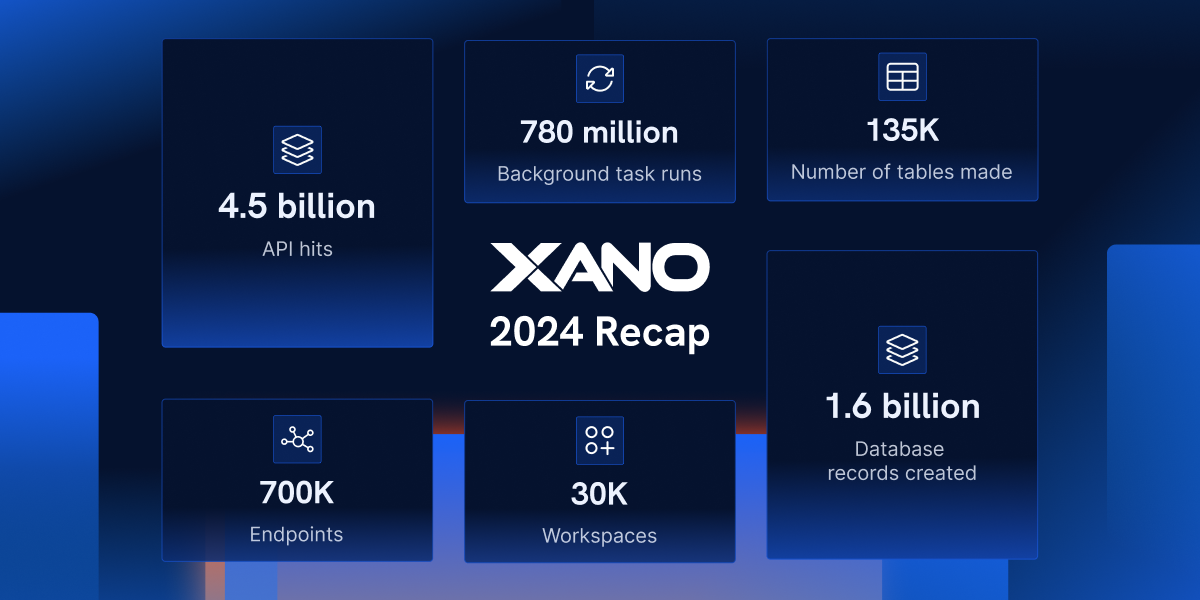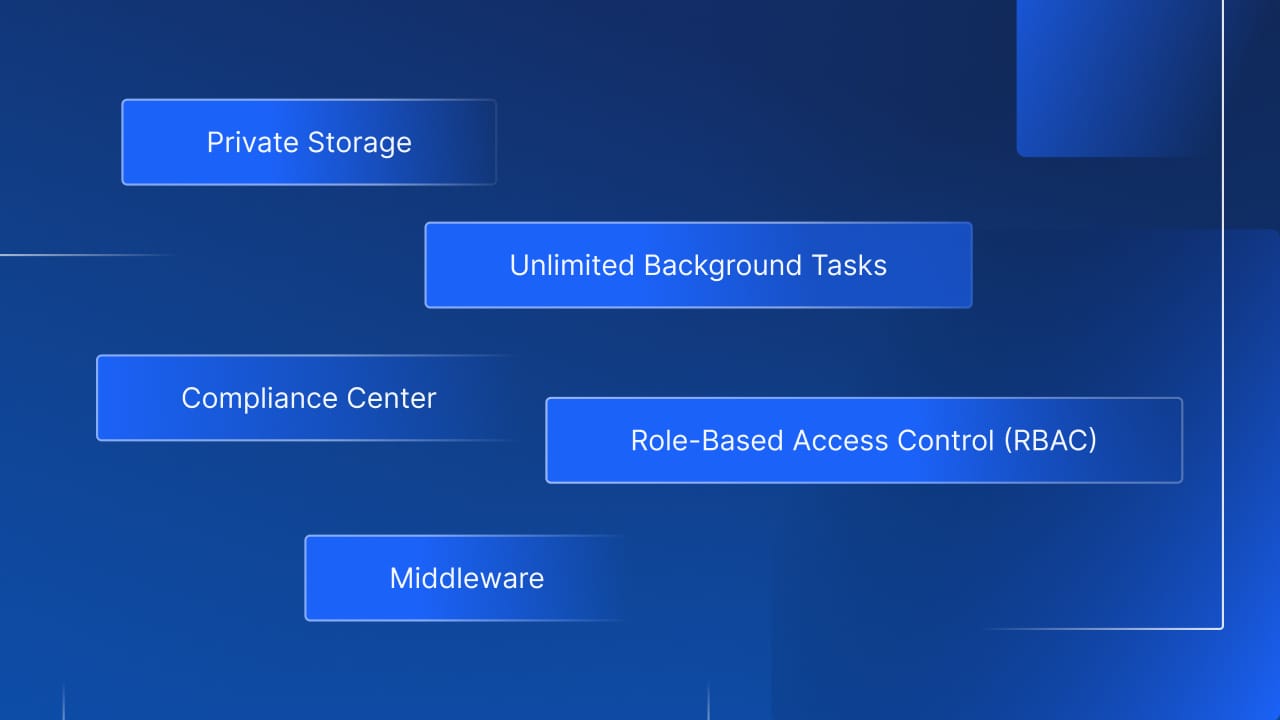Guide To No code: Improving Work Processes
By Xano | August 21, 2021

No code and low code platforms have emerged in recent years as viable solutions for organizations in need of new information systems. In the past, acquiring new software for internal processes was a timely, expensive process. Businesses could either build a new system from scratch using their own team of developers or pay a third party.
Now, thanks to no code platforms, you can create and implement new systems quickly and efficiently – often without extensive programming experience. This can improve work processes across the board and automate a lot of tiresome housekeeping tasks that eat up company time.
Below, we will go over the basics of no code platforms and how they can benefit your company.
No Code Platforms: The Basics
No code platforms are similar to popular sites like WordPress and SquareSpace, which allow anyone to build a website. No code platforms use drag-and-drop and point-and-click configurations to create a simple visual development interface that does not require extensive programming experience to use.
With the templates provided, anyone can create an application, website, or more with zero experience coding required. You can also tweak and alter features as needed without needing to put in IT requests and wait for developers to complete often complicated backend tasks.
In recent years, the rise of no code platforms has led to more advanced capabilities. No code platforms were once mostly used for simple apps, but now some platforms allow you to build very sophisticated software products on a backend platform. In fact, building end-to-end enterprise applications is now possible on no code platforms, although you will likely still need a team of developers to assist you during the process.
A tech team is an extraneous expenditure. No code solutions are usually designed for people with limited technical skills and experience rather than software developers or other people in high-end tech jobs. While no code solutions come with considerable advantages, they still have certain limitations, which we will touch on more below.
No Code Products
Website Builders
These are probably still the most prominent no code products and include sites like Webflow and Wix and even Shopify could potentially qualify. They allow you to build a website in only a few hours and are often used by ecommerce businesses looking to get up and running fast.
Mobile App Builders
Gaining more traction in recent years, mobile app builders allow users to develop apps using a visual editor. The process is designed to be simple for all users, including those without a tech background. Once your app is build, no code platforms also simplify the process of adding new features, allowing your app to evolve over time.
Advanced Spreadsheets
These are similar to run-of-the-mill spreadsheets you could make using programs like Excel, but come with more advanced functionality by providing plugins to build basic business processes. They can be particularly useful to keep data consistent across multiple channels.
Backend
Designed to create and host data structures and APIs. These can be helpful for those with a limited budget looking to create things like apps, data driven websites, MVPs or even powering internal tools. Modern platforms can be used to even build complex backends.
E2E No code Platforms
Mainly used for applications mainly used for internal operations and client relationships, E2E no code platforms help build web and mobile apps that incorporate both business logic and UI. They can cut down on the cost of staffing, although you will still need a development team with a basic understanding of programming.
Internal Tool Builders
These are used to integrate two or more data sources or a backend platform through APIs. This means you may not need to hire a developer to do things like connect sources for visual workflow builders and map different kinds of data.
How Do Companies Use No code?
No code services can automate complex backend tasks, including API integration, so development that would normally take months can be done in just a few days. This means creating tools to streamline company processes is much easier. If you have been putting off automating certain tasks or developing internal applications due to time and budget limitations, a no code platform can help
There are many different uses for no code solutions within a company and how you use a no code platform is truly dependent on your needs. In short, you can do a lot of different types of work with no code platforms, but some of the mores common uses include:
Application Development
Probably the most common use for no code platforms – especially for smaller businesses – is to develop applications for internal use. This includes tools for basic tasks like human resource management and restaurant reservations.
While larger businesses may need to hire an outside team of programmers for more complex applications, many small businesses are saving time and money by opting for no code platforms instead. Rather than relying on third party software, which does not always meet your specific needs, building your own applications with no code platforms allow companies to create exactly what they need to accomplish a given task.
Small-Scale Automation
Large-scale enterprise processes are often handled by professional developers, but a surprising amount of smaller workflows can be automated with no code platforms. You can create applications that perform functions like reaching into databases, emails, and transactional systems to perform the same duties a human might perform.
For example, a small-scale application could automate email notifications for late timesheets or unsigned paperwork, freeing up your team to focus on more complex tasks.
Visual Analytics
Visual analytics can be extremely useful for delivering insights to your team in a clear, concise manner. No code platforms can help generate visualizations of complex information in a digestible format, helping foster stronger communication and understanding across all teams.
Some vendors are even finding ways to use no code and low code platforms to create predictive analytics and machine learning software, but this may require slightly more technical skills (we will go over the limitations of no code platforms in detail below.).
How No Code Improves Work Processes
No code platforms can actually help software engineers smooth out their processes in a variety of ways. Advantages include:
- Increased agility
- Reduce development costs
- Better productivity
- More transparency between teams
How you make the most of a no code platform really comes down to your specific needs as a team, but we will go over some possibilities and potential outcomes below.
Consolidate All Your Software With Less Platforms
Working with no code software means you can replace some third-party, single-duty applications with less, more unified systems. Everything from CRM to messaging apps to HR functions can be consolidated.
With no code software, you can build custom applications for your own company rather than relying on many single-duty third party software that often does not meet your specific needs. Using your own applications can eliminate inefficiencies and help you trim redundant company software.
Unified Communication
No code applications are designed to make in-app conversations simple. This allows your team to essentially record communication that occurs surrounding a single project. You can tag and reply to colleagues as needed, helping to streamline conversations – something that is especially useful with the rise of remote offices.
Conversations can also be saved and referred to in the future, which can help with onboarding new team members and locating solutions for common problems quickly and efficiently.
Helps With Metrics & Reporting
As we touched on earlier, data collected from automated workflows can be used to generate reports complete with visual aids and graphics. Rather than getting bombarded with confusing data, your team can view reports – often generated in real time – that give you a concise summary of exactly what you need to know.
This helps you gain control over your workflow and allows you to gain insights more easily. Rather than spending hours parsing through data to identify inefficiencies and errors, you will be able to spot issues right away, leading to more informed decision-making and increased transparency.
Promotes Interaction Between Teams
There is often considerable disconnect between the tech team and the rest of the company. As No code platforms are designed for those without tech experience, this helps facilitate more transparency between departments.
Non-technical professionals can have more say in building and improving applications, which can help you team of developers shift focus from routine and often monotonous coding to more important projects.
Simplifies Bug Fixes And Changes
One small human error can dismantle an entire internal system, and fixing the issue can often take days. No code app builders automate code, eliminating the risk for human error, meaning your tech team spends less time on manual editing.
Less manual editing also means faster changes. Oftentimes, even a tiny tweak to an application can take several days of work to code. With no code builders, it can only a few minutes to integrate a new feature using built-in plug-ins and drag-and-drop interface.
Does No Code Have Limitations?
If you think no code platforms can replace your entire IT team, that is not a realistic expectation. No code platforms show tremendous promise in terms of simplifying many basic tasks, but they do come with certain limitations. As of right now, not every task can be accomplished using a no code platform, especially for those without a background in coding, and having a developer team on staff can still be important.
To use a no code platform successfully, you need to understand what you want. No code or low code does not necessarily mean no complexity. This means recognizing what makes an application successful, meaning you do need at least some knowledge of software development to make the most out of no code platforms. Those without any background in programming likely will struggle to build an app from scratch, even with the help of a no code or low code platform.
Templates can sometimes inhibit creativity and innovation as they can be too rigid depending on the provider. You usually can only use the templates available on a given platform. If an element you need is missing, you will not be able to use it in your application without figuring out often complex workarounds.
You do not own the source code when working with no code platforms. Having complicated backend tasks automated can be a blessing and a curse. Not owning the source code may create issues if you ever want to switch to another backend service.
Security concerns are also common when working with no code platforms as you do not control the technology stack. This could potentially make sensitive company data vulnerable to third party infiltration, which is why it is important to ask questions or understand what components or security practices comprise a company's technology stack. Also, it may be smart to read terms of service agreements and contracts carefully before choosing a provider.
You can mitigate some of these concerns by doing your research and working with a reputable vendor, but most no code platforms won't be a magic fix for any and all tech processes. No code platforms are changing all the time and becoming more advanced, so some of these issues may become less of a concern in the months and years to come.
However, even then, a strong tech background will likely always be necessary when using a no code platform. Software engineers and similar positions will still be necessary, even as the no code industry continues to grow.
The Bottom Line
In many ways, no code platforms help give your team their time back. With data, communication, and workflows organized automatically, this frees your team from many necessary but often monotonous, draining tasks. This means they will have more energy to expend on more complex work, allowing them to identify ways to better your business overall.
Working with no code platforms does entail a learning curve, but they are designed to be accessible to even those without a programming background. While it may take some trial and error to learn how to navigate a no code platform, the increased efficiency and faster problem solving are well worth the effort.
Looking for solutions for your company? Xano is the fastest No Code Backend development platform on the market. We give you a scalable server, a flexible database, and a No code API builder that can transform, filter, and integrate with data from anywhere. Sign up here to get started.
The post Guide To No code: Improving Work Processes appeared first on Xano.

















